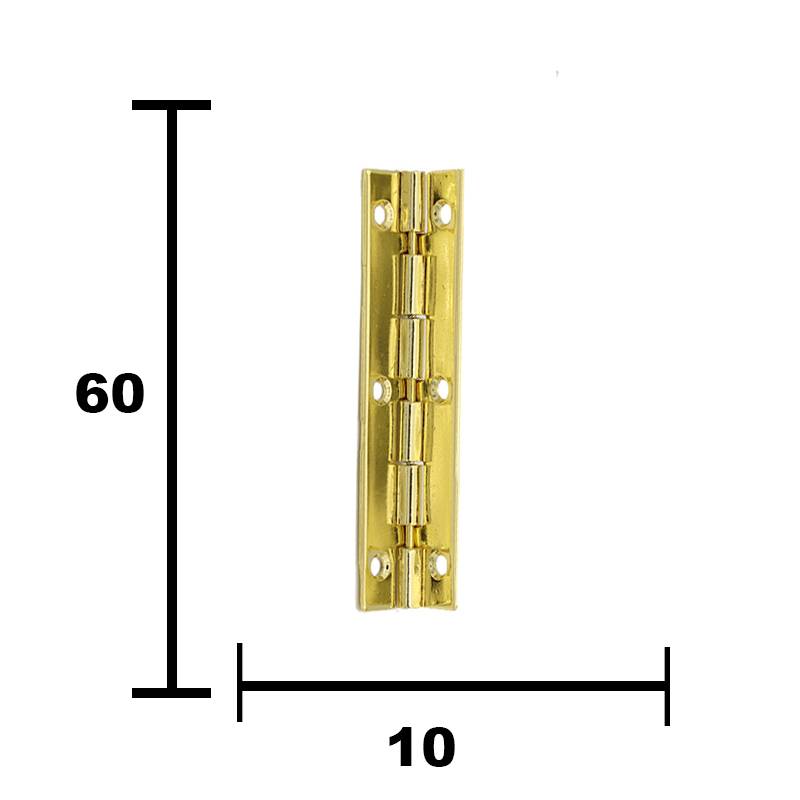





| Product Name: | Box butt hinge | Product Code: | PD012 |
| Color: | Gold,welcome to customize | Material: | Iron |
| Length: | 60MM | Width: | 10MM |
| Opening Angle: | 95 Degree | Surface Treatment: | Hanging Plating Or Rolling Plating |
| Weight: | 10Gram | Sample: | Free&Available |
A 60mm box butt hinge is a mechanical fastener designed to connect the lid and body of a wooden box, allowing one part to pivot smoothly around a fixed axis. The “60mm” refers to the length of the hinge (about 2.36 inches), making it suitable for medium-sized jewelry boxes, keepsake chests, toolboxes, gift cases, and other wooden crafts.
Butt hinges are one of the oldest and most reliable types of hinges, valued for their durability, ease of installation, and compact profile. The 60mm size strikes a balance between strength and discreetness, providing a secure, professional look for both amateur and commercial woodworkers.
Medium Size Versatility:
At 60mm (2.36"), this hinge is neither too small nor too large, ideal for a range of box types up to small cabinets.
Flush Surface Mount:
Designed for surface or mortise mounting, creating a neat fit at the joint with minimal protrusion.
Precision Alignment:
Dual-leaf design ensures smooth operation and tight closure of lids.
Support for Moderate Loads:
Strong enough to support medium-weight wood box lids, trays, and doors with stability.
Screw Hole Pattern:
Typically 4–6 countersunk holes per hinge for firm attachment with matching wood screws (often supplied).
Material Options:
Available in stainless steel, solid brass, electroplated steel, antique bronze, black, gold, nickel, or custom colors/finishes.
A box butt hinge is formed from two interlocking rectangular leaves joined by a central pin or rod that acts as a pivot point. Each leaf is attached to opposite box surfaces (typically the lid and side/back panel). When the lid is opened or closed, the hinge’s pin allows smooth rotation while the leaves keep the alignment steady.
A typical 60mm butt hinge consists of:
Classic design; leaves are of equal length and width, easy to install.
Central pin can be removed, allowing you to separate the box lid without unscrewing the hinge.
More secure (non-removable); suitable for high-value or display boxes.
Ornate leaf designs, engravings, or special surface patterns to enhance appearance.
Thicker gauge metal and wider leaves to carry heavier box or small cabinet lids/doors.
| Parameter | Specification |
|---|---|
| Length | 60mm (2.36 inches) |
| Width | 20-30mm (varies by model) |
| Pin Diameter | 2.0–3.0mm |
| Leaf Thickness | 1.2–2.0mm |
| Hole Pattern | 2–3 per leaf (4–6 total), countersunk |
| Material | Solid brass, stainless steel, iron, zinc |
| Finish | Polished, antique, black, gold, satin, custom |
| Weight Support | 0.5–2kg per pair (depends on gauge) |
| Application | Wooden box lid, cabinet, drawer, craft |
Perfect Size for Medium Boxes:
Not too bulky, not too delicate—ensures enough strength for regular use without overwhelming the box’s design.
Wide Compatibility:
Works with most hard and soft woods, plywood, MDF, and composite materials.
Enhanced Appearance:
When surface-mounted or mortised, a brass or stainless finish adds a touch of luxury and an authentic “handmade” look.
Secure & Durable:
When correctly installed, these hinges outlast cheap alternatives and stand up to years of opening and closing.
Affordable & Accessible:
Available globally, with a huge variety of finish options and price points.
1. Solid Brass
Best for luxury, classic appeal, anti-rust, and patina development over time.
2. Stainless Steel
Modern, highly durable, corrosion-proof—ideal for kitchen, bathroom, humidors, or outdoor boxes.
3. Iron or Zinc Alloy (Plated)
Economical, can be polished, plated, or painted to imitate costlier metals.
Surface Finishes:
Most box makers choose brass or plated finishes for fine jewelry or gift boxes, and satin/black for contemporary crafts.
| Feature | 60mm Box Butt Hinge | Barrel/Cylinder Hinge | Continuous (Piano) Hinge | Concealed Hinge |
|---|---|---|---|---|
| Visibility (Closed) | Partially visible | Hidden | Visible along the length | Hidden, usually inside |
| Installation | Easy/moderate | Moderate, needs drilling | Moderate, full length | Moderate, needs precision |
| Security | Good | Excellent | Good | Excellent |
| Durability | High (brass/steel) | High (brass) | High (steel) | High |
| Decorative Options | Many | Few | Few | Few |
Size Matching:
Lid Weight:
Aesthetic Fit:
Material Compatibility:
Decoration:
1. Mark Your Placement
2. Mortise Preparation (Optional)
Tips:
60mm box butt hinge, 60mm butt hinge for wooden box, box hinge 60mm, brass butt hinge 60mm, stainless steel box butt hinge, decorative box butt hinge, small box hinge, wooden box hardware, jewelry box butt hinge, keepsake box hinge, gold box hinge, satin box butt hinge, hinge for gift box, 60mm cabinet hinge, OEM box hinges, hardware for wooden chest.
| Attribute | Description |
|---|---|
| Hinge Length | 60mm (2.36 inches) |
| Hinge Width | 22mm per leaf (varies by model) |
| Leaf Thickness | 1.2–1.5mm |
| Center Pin | Solid brass/stainless steel |
| Screws Included | Yes; matching finish |
| Finish | Polished, antique, nickel, black, gold |
| Operating Angle | Up to 270° |
| Load Capacity | 1.5kg per pair (typical) |
| Application | Wooden boxes, cabinets, drawers |
Ready to elevate your next box project with reliable, beautiful 60mm box butt hinges?
Contact our team for catalogs, free samples, specification matching, OEM quotes, and fast delivery worldwide. Explore how the right hinge transforms wood boxes into heirloom-quality, luxury, or practical products—all at a competitive price.

Copyright © 2021 GEXIN ALL RIGHTS RESERVED
